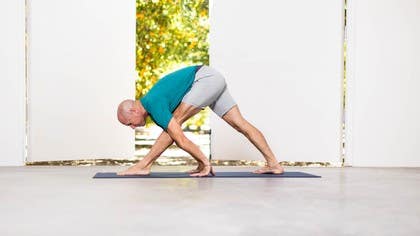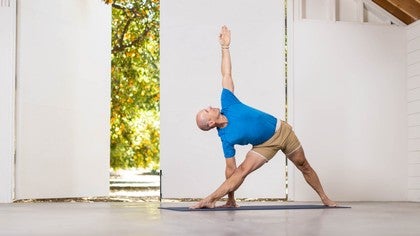Description
About This Video
Transcript
Read Full Transcript
Hello and welcome back. In this lesson we're going to learn how to create a powerful support system throughout the body using the core and the strength of the legs in lateral standing poses. To start out today we're going to warm up in some sun salutations. We'll start over at the head of the mat and feet together. We'll start out with some ideas that we're familiar with from the previous lessons and that is setting up the circle of energy through the body. To start we'll gently tip the waistband back until you feel a little bit of contraction in the backs of the legs, the hamstrings, the buttocks, and root down, ground into the floor with that feeling. Front of the body, the energy is moving up, back of the body, we're grounding down. Let's start by raising up the arms with an inhale and then back down. And as we raise the arms we try not to distort, so I'm going to distort now so you know what I mean by that, by falling out of that circle of energy. So we keep a little restraint on the front of the body, ribs are calm and quiet, arms up on an inhale, exhale, arms down. One more time. Inhale, arms up and exhale, arms down. Let's add to it now. Arms up, inhale, exhale, bend the knees, reach down, touch the floor, drop the hips as much as you feel okay to do. Come back up, arms up with a breath in and again, bending the knees. Squat down as far as you feel comfortable to go, we'll do one more. Arms up with a breath in and again, bending the knees, touch the hands to the floor, we'll step the left leg back, we're in a long lunge. As we were learning in the previous lesson, we gently tuck under, gently tuck so we feel the strength of the hamstrings support this pose. Then step back to a plank, connect with the abdominals, bend the elbows and come all the way to the floor. Point your toes, let's take an easy baby cobra, hold there. Release and tuck the toes, hands and knees, downward facing dog. The bones of the arm, the shoulders should be lifting as we deepen into the pose, that keeps the shoulder joints happy and healthy. We can pedal the legs just a little bit, one heel lifting, one heel pressing down into the mat. Back and forth as we warm up the body. And one more time, press the heels down, raise the heels up, look forward and now left leg forward through to the hands. A gentle tuck of the hips to create the support system underneath the legs. Step forward, feet a little bit apart, bend the knees, drop down as far as you feel comfortable to go. This help warms up the muscles of the hips and legs and then we'll stand all the way back up, arms to the sky. And then hands back down. Let's start again. Front of the body lifting, back of the body grounding, arms up. Bend the knees, touch down the hands. This time right leg back, gentle tuck of the hips to create support from under the legs. Plank pose. Tipping the waistband slightly up to engage the abdominals. Take a breath in on your exhale all the way to the floor. Point the toes and lift your chest just a little. Little back bend. Release the chest, tuck your toes, pressing into a downward facing dog. Let's take one more opportunity to pedal out the legs. Couple more times, one heel lifting, one heel pressing. Let's press both heels down into the ground, holding there, lifting arm bones. Then raise the heels and look forward. Right foot forward. Gentle tuck of the hips. Feel the legs, feel the hamstrings support this pose. Step forward. We'll bend the knees, lower the hips. Come down as far as you like. If you can even drop your hips all the way down to the heels, go for it. If not, it's completely okay. We're just warming up the joints and then inhale. Come all the way up, arms to the sky and hands down. Let's move into a little bit more in sun salutation B. Feet together for this one, front of the body lifting, back of the body grounding down. Inhale, arms up. With an exhale, we'll sit down into chair pose, waistband a little bit back until you feel the connection of the hamstrings. Take the hands to the floor. We'll step straight back into a plank now. Holding here for just a moment, waistband up, connect your abdominals, come halfway down. Chaturanga. Pushing over the toes, upward facing dog to downward facing dog. And then looking forward, step your right foot between your hands. We'll roll the left heel down to the yoga mat. Gentle pelvic tuck. Connect to your hamstrings, coming up into warrior one. Hands down, step back, plank pose, connect to the abdominals and come halfway down. Chaturanga, holding that connection to the abdominals the whole way and then we scoop to upward facing dog. And a down dog. Look forward, it's now left hand, sorry, left foot in between the hands. Connecting to the hamstring, left leg, hamstring right leg. And we'll tip the right heel down. Coming up again to warrior one.
Raise the arms. Hands to the floor, step back, plank pose. Connecting to the abdominals, bend the elbows, we'll go halfway down. Push over the toes, upward facing dog. Downward dog. And then to come forward, you can either step to the front of the mat or feet together, elbows up, look forward, bend your knees and jump to the front. With feet together, bend your knees, drop your hips a little, waistband back to connect to your hamstring support system, arms up for chair pose. Knees can come forward of the toes in this pose. And come all the way out. Let's pause, relax in tadasana, let the breath cool down. And then let's take a step out wide along the long edge of the mat. We're going to set up now that support system I was talking about from the core and the strength of the legs. To begin in this pose, prasarita padasana, we'll start by taking the waistband slightly back. And we're going just slightly back enough until we feel the hamstrings, the glutes strongly engage. That gives us that grounding energy and you'll feel this in the lateral poses that we do really helps to support the opening of the pose. In this position, front of the pelvis lifting up to the front, down to the back, and we'll stretch out the arms. When you stretch out the arms, there can be a tendency to want to protrude the ribs forward. We're going to tame the ribs, bring them back into the body line. Hold there. And then relax the hands of the hips. We'll turn the left foot in just slightly and the right leg out 90 degrees. This is side angle pose or parjvokanasana. We'll begin with that gentle tuck, tailbone slightly down and bend the knee a little. To find the support system in this pose, take the right hand against your thigh, give some resistance to that thigh and you'll see this cycle that I'm talking about. Watch my sitting bone go towards the knee. Can you see that? I'm creating a connection from a hamstring to the back of the knee and I'm using the resistance here to lift this hip bone. Okay, we'll keep that for just a minute. Try it one more time. Sitting bone a little bit toward the back of the knee, lifting the top of the right hip. We're going to keep that as we go slowly towards the pose. My mind is holding that connection, holding that connection, holding that connection. And then I touch at my level. If you need a block to support, if you have one nearby, absolutely you can take it. But now we're going to do a test. Feel what happens if you let go of that support. I'm going to do that now. You see my body has totally collapsed in the pose. There's no more support. There's no more way to lift the internal body. Come out a little, put the hand on the thigh, re-engage that support system and once again come in. It's a little bit more work, but the reward is the openness in the body. Then we'll take the top arm over the ear to complete the pose. Hold here. You're feeling the work of the support and the gift of openness in the body. Then inhale, sweep up to standing. Turn the feet in, hands on hips. Take a pause. Let's reload the support system. Waistband a little back, pressing down through the back of the body, lifting through the front. Right toes a little in, left leg out. Take your hand to the thigh, left hand, left thigh. Lift this hip a little. Feel the connection from sitting bone to the back of the knee and we'll keep that. Use your mind there, your awareness to hold that connection as we go down into the pose. Take it down to your level. Waistband tipping gently back, sits bone held to the knee. Take your top arm over. We won't do the test this time because you know how it feels. So I want you to keep with this work here with the support to help open up the body. The feeling with the support is you can start to lift the organs of the abdomen upward. That's where we gain a lot of power and strength in yoga is the toning of the abdominal organs. Then inhale, come up, turn the feet to center, hands on hips, walk your legs in to rest. Take a few breaths and then we'll step out wide. It's a quick rest as we work into triangle pose.
Set up your support. Waistband back, pressing down through the heels. Left toes in, right leg out. For this pose we're going to tip slightly in. I use my resistance again. We feel the sitting bone. We want to tuck. Can you see that? Where I press from the sits bone to the heel. Then I'll keep that feeling of connection at the back of the leg and come into my level again. Hand on shin. It could be hand to floor. Whatever works best for you. My mind, like a meditation, has got that connection locked in. Then I can take the top arm up. Keep breathing. If you can, in and out through the nose only to come up, use that connection, that hamstring to push the sitting bone into the heel. And that's what brings us up. Legs to center. Right toes a little in, left leg out 90 degrees. We'll tip into the pose just a little. Front of the pelvis up, back of the pelvis a little down. Remember these are subtle movements. We're not trying to super tuck, right? Hand on the thigh, create that resistance so that you can press the sitting bone toward the heel. I have that connection now. Now with that support system in place, I can take it to my level. You take your pose to your level. That meditation again of holding the strength, the power, the support underneath the leg so that I can open here. The lifting of the organs this direction. Top arm up. It comes from all the way at the base of the pelvis, that internal lift. And then to come up out of the pose, I'm going to use the hamstring to help pull the sitting bone toward the heel to lift. Turn the feet to center. Walk the legs together to rest. Alright, we're getting it. We're learning that support system. Next we'll take warrior two. Legs out wide again. Waistband a little back, pressing the sitting bones to the heels. We're grounded through the legs. Turn the left toes a little in and the right leg out 90 degrees. Stretch the arms. So now we don't have that support system. We're going to take the arms away, bend the knee a little. Can you find it without that resistance that we've been using? Gently move the right sitting bone towards the right knee. And coming into the pose. Holding here. I feel the resistance of the shin pushing back to the sitting bone. The sitting bone engaged toward the knee. And it creates a support for the pelvis. That's where we get to lift and tone all of the abdominal organs. Hold here. Definitely can work up a sweat doing these standing poses. It's good for us. And then straighten the leg. Rest your arms. Turn the feet to center. Let's do the other side. Straight foot in. Left leg out 90 degrees. Waistband a little back. Start to bend a little. I press down through my heel to make a connection from that sitting bone to the back of the knee. And then I'll extend into the pose a little. My left shin pushing toward the sitting bone. Sitting bone pressing toward the back of the knee. That creates a support system for the middle of the body. And then extend the arms. You can look over your left arm.
Remember we're doing to get. We're doing the support here so that we feel that there's a way to lift internally. That's the goal. We're doing this to find something new. And then straighten the leg. Turn the feet to center. Walk the legs together to rest. Then in Tadasana can we find that same internal lift that we've worked on in the lateral poses. Gently waistband back. Down with the back. Up in the front. Can you create that lift? We'll take the arms together. Invert the palms. And raise up. Now the arms, they help us find the inner body. By that I mean by taking the arms up with quiet and tamed ribs you can feel the entire inside of your body lift toward the heart. Helping engage and tone all of that fascia, the musculature and the organs themselves. And then rest. One more half moon pose for this one. Feet a little bit narrower. We're going to start by turning the left foot in and the right leg out. And go back to the first pose we did here, the lateral pose. We're going to create that support system. Pressing onto the thigh, I'm going to create that little engagement from the hamstring, sits bone to the back of the knee. Keep that as we fold into the floor. Right hand down. Walk the back leg in a little. Hand out a little. Put the weight over the leg. We've got that connection. The sitting bone towards the right heel. And you do your best to straighten the leg. And my hope here is in engaging these muscles in this way, you feel the back of the leg is like a wall. Very, very strong wall that you can rely on to then open the rest of the body. I'll be quiet for a minute and let it hold onto your pose. Carefully, slowly touch down. Come back up to standing. Just revolve the other side. An easy bend of the left leg. Here's our resistance so we can learn to connect. I'm making that movement right here. Connect. Sitting bone to the back of the knee. Keep that support system. Touch the floor. We'll take the back leg, walk in a little. Support system. Hand out. And then bring the body weight over the left leg. Keep that hamstring awareness on and bring the leg up. Create that supportive backstop, that wall in the back of the left leg. Be in the pose. And then slowly down. Come back up. Turn in. Feet together. Sometimes that pose can be really challenging to hold balance. If you have a wall at home, you can practice there to get rid of the balance challenge and just really work on learning that support system. Take a moment here to just rest. Catch your breath. Let's do one more internal lift. Hands together. Invert the palms. Waistband a little back. Ribs are calm and quiet. Then if you watch my arms, see how I engage them to lift the body. Here they go. And you see how that takes the whole system up? How the abdomen draws back and up? Hold there. Pressing down to the legs to take the front body up.
And then relax. Let's turn back to the front of the mat. Feet together and we'll flow through to downward facing dog. Arms up. Ribs quiet. Exhale. Forward fold. Legs straight this time. Take a breath. On your exhale, take as much of a forward bend as you can do today. Back of the body reaching down. Tucking in chest to thighs. Hands down to the floor. Step back. Plank pose. Connect to your abdominals. Come halfway down. Push over the toes. We're an upward facing dog. Here again, you can use that lift of the front of the body to support the spine. And then downward facing dog. Perfect time for a child's pose. Drop the knees, feet together. Sit back as you can and make a nice arm pillow for your forehead. Take a few breaths. Slow your heart rate. And let's work our way to sitting. We are going to jump into crow pose next. I'm going to try to show you a variation where typically when we do crow pose, the hips are way up high in the air. I'm going to show you a way to use the core in a very different way to instead lift your mid body up in the air and see how strong this pose can relate to your core. To do that, we'll bring the feet together, hands on the floor like you see me doing here. With the heels up as high as possible, sit down toward the heels. You can work your knees open and closed a little bit so you feel well snuggled into this pose. The first move is we have to get the knees to the upper tricep and behind the armpits. So I'm going to lift a little, tuck an arm. See where that knee is right at the top of the shoulder? That's important. We want that position. Same with the other arm. Slide the hand back, tuck your arm. To feel what I'm talking about in this, the lift of the upper body, lean up on your arms a little bit and dig your knees into your triceps. Here comes my middle back. You see it lift? It wasn't my butt that lifted. Middle back. Back out of the pose for a minute, take a break, knees down. I'm going to try it again.
Put all that into practice one more time. Lean back onto the tippy toes, hips up, tuck an arm, tuck an arm. Helps to do that on an exhale. Then lift your hips a little, let your body weight come down onto your knees, lean forward onto the arms a little. To come into the pose this time, dig your knees straight down onto the arms and lift your middle body to the sky. It's all about the pressure of the knees onto the backs of the arms. You see how round my body is. Very much a core pose. Come down, take a little rest. Child's pose. I'd love to hear how that went for you. If you want to leave a comment after you're done with our session and let's see if we can help take it even further. And then come back up to sitting. I'm going to do a wide leg seated pose here and take all the things we've been learning into this next pose. We're going to start off to the left side by first leaning and hooking the left elbow against. This connection here allows me to put resistance and I can start to create a connection from my ribs to the hips. Do that with me a few times. Press, create some resistance and feel like you can squeeze your left ribs towards your hip a little bit. Let it go. Side two. Elbow. Press. Squeeze. Let go. Ribs to hips. Squeeze. Let go. First side. All the same things. Press and squeeze. Connect this area and we're going to start to turn towards the ceiling. One secret note here. This hip has to come off the ground. I'm doing that now. You see how it spills me toward the leg? Otherwise the spine, you can over stretch it and hurt the spine. So we want to keep that spine moving over the leg. Reconnect. Press. Turn. If it's available to you, grab hold. If not, hand in front. Grab hold and start to turn. Keep the connection with your left ribbed pelvis. So the spine has a nice arc to it. And then gently turn toward the floor. Unlock and come up. Second side. Lean. Connect the elbow. Create a connection from rib to hip. Pressing in. Turn a little bit more. Remember the secret? You've got to let this side, the left buttock bone come off. Come off the floor. Press. Turn. Chest up. Hand on the floor or you can lock against the foot. Keep the connection at your right waist and turn. Gently turn back to the floor and come up. Powerful pose. But we have the support system to keep it happy. Bring the legs in. Turn to lie down on your back. Knees bent. Take just a second here to take a few breaths. Let it go. It's a strong session today. And then our counter pose. We've been doing this in some of the previous lessons. It's just such a lovely way to take the back the other direction. Hold onto the mat. Tip your waistband back. Lift your hips. Tuck your shoulders. Create your cycle of energy. Front of the body gently rolling toward the top of the chest. Back of the body rolling toward the knees and calves.
Hold here. I don't want you to be going 100% here at all. You feel the muscle work of the legs, but you should not be feeling tons and tons of work. Gently release down. Untuck the shoulders. A breath or two and we'll do it one more time. Let's do it. Waistband gently down to the floor. Raise the hips. Snuggle the shoulders behind your back. You know the snuggling of the shoulders actually creates a space for your upper spine to relax down into the floor. We don't want to jam the chest into the chin. That's too much for the neck. Instead you create space with the shoulders by tucking them under and allow your middle and upper back to fall down. Now we can lift up a little more without any strain on the neck. Middle and upper back curving. And then untuck the shoulders. Release the pose. Sway the hips a little left and right. A few nice long breaths if you can. In and out through your nose. Start to relax your tummy. Relax the muscles of the back. We're headed toward Shavasana. Let the legs come to center. Set the arms down on the floor a little bit away from your body so there's some space for your chest. Slightly, ever so slightly, tuck the shoulders under. And when you're tucking the shoulders, you don't want to create a grip of the back muscles. The rib cage, the middle and low back should be totally soft. And then one leg at a time. Reach the legs long toward the mat but not 100%. Leave a little bend in the knee and then the other leg as well. And with some resistance in the heels, kind of stuck to your yoga mat, slowly let the knees descend rather than push the legs out. Let the knees descend. And my hope is you feel this creates a soft, soft, quiet abdomen. When the legs have fully met the ground, take the energy away from the legs. Let the legs roll to their respective sides and slowly let the legs completely relax. Arms are soft, belly is soft. Eyes close. Muscles at the back, completely soft, body is given over to the ground. Let the attention relax and reside in the soft abdominal area.
Stay for as long as you like in your savasana. The longer you stay, the quieter the nervous system becomes and the more ready you can be to enter your day. If you are ready to come out, turn softly onto your side by bending your legs one at a time. Feet on the floor. Turn over to your right side. We'll pause on the right side for just a minute. Rest your head in your hands. And then using your hands, softly press yourself up to sitting. We'll take a quiet moment in the cross legs position or any position that feels good to you. Great to have you here. I hope you enjoyed that lesson in the lateral poses and the feeling, the strength and the core and the legs. Looking forward to seeing you in the next lesson. Namaste. Have a wonderful day.
Advanced Basics
Comments
You need to be a subscriber to post a comment.
Please Log In or Create an Account to start your free trial.



















